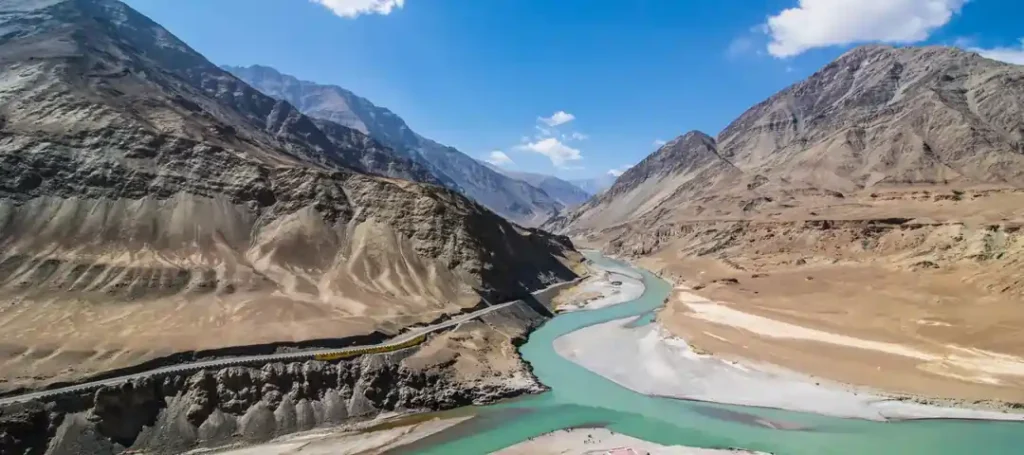New Delhi: In a landmark achievement for environmental conservation, India’s Cold Desert Biosphere Reserve has been officially inducted into UNESCO’s World Network of Biosphere Reserves (WNBR). Located in the trans-Himalayan region of Himachal Pradesh, this high-altitude marvel represents India’s commitment to preserving its unique ecosystems while promoting sustainable development. The designation, announced on September 27, 2025, elevates India’s standing in global biodiversity efforts and underscores the importance of protecting fragile cold desert landscapes.

Exploring the Cold Desert Biosphere Reserve
Spanning approximately 7,770 square kilometers in Himachal Pradesh’s Lahaul-Spiti district, the Cold Desert Biosphere Reserve is a breathtaking expanse of rugged terrain. Its landscape features windswept plateaus, glacial valleys, alpine lakes, and stark high-altitude deserts, making it one of the coldest and driest ecosystems in the WNBR. With altitudes ranging from 3,300 to 6,600 meters, the reserve encompasses protected areas like Pin Valley National Park and the Kibber and Chandratal Wildlife Sanctuaries, which serve as critical havens for biodiversity.
The reserve is a botanical treasure trove, harboring 732 species of vascular plants, including 30 endemic and 157 near-endemic species of the Indian Himalayas. Hardy alpine grasses, medicinal herbs, and rare stands of Willow-leaved sea-buckthorn, Himalayan birch, and Persian juniper thrive in this harsh environment, showcasing nature’s resilience. These plants not only support local ecosystems but also hold significant value for scientific research and traditional medicine.
The fauna of the Cold Desert Biosphere Reserve is equally remarkable. Home to iconic species such as the elusive snow leopard, Himalayan ibex, blue sheep, and Himalayan wolf, the reserve is a sanctuary for wildlife adapted to extreme conditions. Birdlife flourishes here as well, with species like the Himalayan snowcock and golden eagle soaring above the rugged terrain. This rich biodiversity positions the reserve as a global model for balancing conservation with human coexistence.
A Thriving Human Presence
Approximately 12,000 inhabitants live within the reserve, residing in scattered villages where they maintain traditional lifestyles in harmony with the environment. Pastoralism, including yak and goat herding, forms the backbone of their economy, alongside small-scale farming of barley and peas suited to the arid climate. The community also practices Tibetan herbal medicine, utilizing local plants for healing, a knowledge system passed down through generations.
Cultural and environmental sustainability is reinforced through Buddhist monastic traditions and community councils. These local governance structures regulate the use of fragile alpine resources, ensuring that human activities remain eco-friendly. This community-driven approach aligns with UNESCO’s vision for biosphere reserves, which emphasizes integrating conservation with sustainable livelihoods.
UNESCO’s Historic Designation
The inclusion of the Cold Desert Biosphere Reserve in the WNBR was formalized during the 37th session of UNESCO’s International Coordinating Council of the Man and the Biosphere (MAB) program, held in Paris on September 27, 2025. The announcement was echoed at the World Congress of Biosphere Reserves in Hangzhou, China, where global leaders gathered to advance conservation strategies.
This year, UNESCO designated 26 new biosphere reserves across 21 countries, marking the highest number of additions in two decades. The WNBR now includes 785 sites across 142 countries, protecting over one million square kilometers of natural areas since 2018—an area equivalent to the size of Bolivia. India’s Cold Desert Biosphere Reserve, first established as a national biosphere in 2009, now joins 12 other Indian sites in this prestigious network, reflecting the nation’s growing role in global conservation.
Union Minister for Environment and Forests Bhupender Yadav celebrated the milestone, stating that the designation highlights India’s dedication to biodiversity conservation and community-led sustainable development. He credited Prime Minister Narendra Modi’s leadership for driving efforts to preserve and restore ecosystems. The recognition follows closely on the addition of two new Ramsar sites to India’s list, bringing the total number of Wetlands of International Importance to 93.
A Global Leap in Conservation
The 2025 designations are a historic moment for the WNBR. Six countries—Angola, Djibouti, Equatorial Guinea, Iceland, Oman, and Tajikistan—welcomed their first biosphere reserves, while Sao Tome and Principe made history as the first nation to have its entire territory designated as a biosphere reserve. New reserves were also announced in Albania, China, Ethiopia, France, Greece, Indonesia, Jordan, Madagascar, Malaysia, Mongolia, Portugal, Saudi Arabia, and Sweden, showcasing UNESCO’s commitment to protecting diverse ecosystems worldwide.
UNESCO Director-General Audrey Azoulay emphasized the significance of this milestone, noting that the WNBR now safeguards 5 percent of the planet’s surface. She highlighted that these reserves are living laboratories where innovative approaches to balancing conservation with sustainable livelihoods are developed daily. Azoulay pledged continued collaboration with states, scientists, civil society, Indigenous communities, and local stakeholders to sustain this momentum.
The announcement coincided with the 5th World Congress of Biosphere Reserves, which brought together over 2,000 experts, decision-makers, civil society representatives, Indigenous leaders, and youth. The congress reviewed the MAB program’s achievements and set a forward-looking agenda for the next decade. Azoulay issued a call to action, urging every UNESCO member state to establish at least one biosphere reserve by 2035 to further expand global conservation efforts.
Significance for Tourism and Research
The UNESCO designation is poised to transform the Cold Desert Biosphere Reserve into a hub for eco-tourism and scientific research. The region’s dramatic landscapes, rare wildlife, and cultural heritage are likely to attract adventurers, nature enthusiasts, and researchers. However, careful management will be essential to mitigate the pressures of increased tourism on this fragile ecosystem, which is already vulnerable to climate change.
For scientists, the reserve offers a unique opportunity to study cold desert ecosystems, endemic species, and climate adaptation strategies. Its inclusion in the WNBR will foster international collaborations, secure funding, and promote knowledge exchange, positioning the reserve as a global leader in high-altitude conservation research.
India’s Broader Environmental Commitment
The Cold Desert Biosphere Reserve’s recognition strengthens India’s position as a leader in Asian conservation. With 13 biosphere reserves now in the WNBR, the country showcases a diverse range of ecosystems, from coastal mangroves to mountain deserts. This achievement aligns with national policies under Prime Minister Modi, which prioritize ecosystem restoration alongside economic development.
The reserve’s community-driven model exemplifies how traditional knowledge can inform modern conservation practices. By integrating local governance with global standards, India is setting a precedent for sustainable development in environmentally sensitive regions.
A Global Model for Sustainability
The inclusion of India’s Cold Desert Biosphere Reserve in UNESCO’s WNBR is a triumph for both the nation and the global conservation community. By protecting this unique ecosystem—complete with its diverse flora, fauna, and human cultures—India and UNESCO are paving the way for a sustainable future. As climate change poses increasing threats, such reserves serve as vital refuges for biodiversity and models for harmonizing human and environmental needs.
This milestone underscores the power of international cooperation in safeguarding the planet’s most fragile ecosystems. With its 13th biosphere reserve, India continues to lead by example, blending tradition, science, and policy to create a greener, more resilient world.
Frequently Asked Questions
1. What is the Cold Desert Biosphere Reserve, and where is it located?
The Cold Desert Biosphere Reserve is a high-altitude ecosystem spanning approximately 7,770 square kilometers in the Lahaul-Spiti district of Himachal Pradesh, India. Located in the trans-Himalayan region, it features windswept plateaus, glacial valleys, alpine lakes, and rugged deserts, with altitudes ranging from 3,300 to 6,600 meters. It includes protected areas like Pin Valley National Park and Kibber and Chandratal Wildlife Sanctuaries.
2. Why was the Cold Desert Biosphere Reserve added to UNESCO’s World Network of Biosphere Reserves?
On September 27, 2025, UNESCO designated the Cold Desert Biosphere Reserve as part of its World Network of Biosphere Reserves (WNBR) due to its unique biodiversity, fragile ecosystem, and sustainable community practices. The reserve, recognized during the 37th session of UNESCO’s Man and the Biosphere (MAB) program in Paris, highlights India’s commitment to conservation and sustainable development, joining 12 other Indian biospheres in the global network.
3. What kind of biodiversity does the Cold Desert Biosphere Reserve support?
The reserve is home to 732 species of vascular plants, including 30 endemic and 157 near-endemic species of the Indian Himalayas. Its flora includes hardy alpine grasses, medicinal herbs, and rare plants like Willow-leaved sea-buckthorn, Himalayan birch, and Persian juniper. The fauna features iconic species such as the snow leopard, Himalayan ibex, blue sheep, Himalayan wolf, and birds like the Himalayan snowcock and golden eagle.
4. How do local communities contribute to the reserve’s sustainability?
Approximately 12,000 inhabitants live in scattered villages within the reserve, practicing traditional pastoralism, yak and goat herding, and farming barley and peas. They also use Tibetan herbal medicine derived from local plants. Buddhist monastic traditions and community councils regulate the use of fragile alpine resources, ensuring sustainable practices that align with UNESCO’s goals for balancing conservation and livelihoods.
5. What are the expected impacts of UNESCO’s recognition on the Cold Desert Biosphere Reserve?
The UNESCO designation is likely to boost eco-tourism and scientific research in the region, attracting visitors and researchers interested in its unique landscapes and biodiversity. However, careful management is needed to protect the fragile ecosystem from tourism pressures and climate change. The recognition also enhances India’s global conservation profile, fostering international collaborations and reinforcing the reserve’s role as a model for sustainable development.

